Schneider Shorts of 8 December 2022 – with a harassed nano-fabricator in France, growing pressure on Stanford president, a resigned dean of Weill Cornell, a resigned psychology editor, a Chilean cheater suspended for 2 months, Elon’s monkey torture, stolen fossils kerfuffle, Elisabeth Bik finds an Easter Egg, and as usual, scholarly publishers misbehaving.
Table of Discontent
Science Elites
- Alles ist hin… – Augustine MK Choi resigned as Weill Cornell dean
- Harassed Jolanda – Spadavecchia, an Italian nano-fabricator in France
- Stanford meltdown – will Marc Tessier-Lavigne quit under pressure from sleuths and media mob?
- Fish, dinosaurs and fraud – Robert DePalma accused by collaborator of faking fossils
- Fiedler off the roof – Psychology chief editor made to resign over racism charges
Industry giants
- Elon having fun – Musk’s monkey-torture business Neuralink under investigation
- Videregen’s new cash – trachea transplant crooks receive another wad of cash from UKRI
Scholarly Publishing
- Not falsification – A passive-aggressive expression of concern for Claudio Hetz
- A lesson learned – Scientific Reports and papermills
- Electrochemical scam – learned society rigging journal metrics
News in Tweets
Science Elites
Alles ist hin…
Augustine MK Choi, the inventor of carbon monoxide as a cure for everything (because one won’t be sick once one dies from suffocation?) was removed as Dean of Weill Cornell Medical School.
O du lieber Augustine MK Choi
Augustine Choi is Dean of Weill Cornell and a misunderstood genius. He discovered that carbon monoxide is a cure for all possible diseases, just add a bit of Photoshop.
Cornell Chronicle announced on 16 November 2022:
“The Cornell Board of Trustees and Weill Cornell Medicine Board of Fellows have approved the appointment of physician-scientist Dr. Francis Lee, chair of the Department of Psychiatry at Weill Cornell Medicine, as interim dean of Weill Cornell Medicine and interim provost for medical affairs of Cornell University, effective Jan. 1.
Lee, who is also psychiatrist-in-chief at NewYork-Presbyterian/Weill Cornell Medical Center, will succeed Dr. Augustine M.K. Choi, who announced in June his intent to return to his research and not seek an additional term. Cornell formed a search committee last summer to select a new dean and provost of medical affairs.”
Choi is thanked for “for his exceptional service as dean” and is “bold vision”. Not much. The fact that they install an interim dean while searching for a new one means Choi did not resign voluntarily and was given a push.
Harassed Jolanda
The French journalist David Larousserie reports for Le Monde (translated):
“It all started in February 2021 with the report, initially anonymous, of suspicions of breaches of scientific integrity addressed to the CNRS referent. He will investigate the case with his university counterpart. The case is about more than twenty recent scientific articles from the Chemistry, Structures, Properties of Biomaterials and Therapeutic Agents (CSPBAT) laboratory in Bobigny. The incriminated work concerns nanomedicine […]
A year later, in May 2022, after consultation with independent experts, the two referents submit their report. The president of the university sends a message to the staff of the CSPBAT, confirming that “several breaches of scientific integrity have actually been observed” and that “the number of corrections requested is significant, but no incriminated article is the subject of ‘a request for withdrawal’. The identity of the suspect, Jolanda Spadavecchia, director of research at the CNRS since 2010, is communicated. The investigation report is not released and the lab knows nothing of the details of the charges, nor the analysis made by the experts consulted. In particular, young interns or doctoral students, who are making their debut in research in this climate, remain in the dark about what is permitted, prohibited, acceptable at the bench. […]
Then the case bounces back. In the summer of 2022, the first decisions of the publishers who published the offending articles fall. Nine corrections to date and, surprise, a retraction decided by a journal, against the advice of the main author.”
Spadavecchia has 10 papers listed on PubPeer. Here is the retracted one:
Fatima Aouidat , Sarah Boumati , Memona Khan , Frederik Tielens , Bich-Thuy Doan , Jolanda Spadavecchia Design and Synthesis of Gold-Gadolinium-Core-Shell Nanoparticles as Contrast Agent: a Smart Way to Future Nanomaterials for Nanomedicine Applications International Journal of Nanomedicine (2019) doi: 10.2147/ijn.s224805
The retraction note from August 2022 stated:

“The authors raised concerns regarding errors that had been made during the calculation of the size of the nanostructures shown in Figure 2. The sizes reported in the histograms of Figure 2; a1, a2 and a3 were incorrect due to miscalculations that occurred during analysis of the gold core and polymer shells of the spherical nanostructures represented in TEM images of Figure 2A. The authors provided the editor with data from the original study and requested to remove the incorrect histograms and replace them.
However, the Editor determined that this part of the article was integral to the study and the admission of these errors, because of the miscalculation, meant the data was unreliable and would not accept the correction proposed by the authors. The Editor requested for the article to be retracted and the authors were notified but do not agree with this decision.“
Spadavecchia’s bad luck was that this Dove Press journal was found to be infested by Chinese papermills and edited by a (now sacked) research fraudster, Thomas Webster. The publisher Taylor & Francis did a clean up, mass-retracted th papermill fraud, sacked Webster. And this is also why Spadavecchia’s fake nano-excretion went where it had to go: flushed down the drain.
Thomas Webster to save the world with COVID-19 nanoparticles
The world is in the grip of COVID-19 pandemic. Thousands dead, infection rates explode, nations in lockdown. Perfect timing for troll scientists to offer their bullshit cures. Like Thomas Webster of Northeastern University.
But the rest was fixed with corrections. Here is one such fresh correction from November 2022, courtesy of CSPBAT and CNRS:
Maelle Monteil , Hanane Moustaoui , Gennaro Picardi , Fatima Aouidat , Nadia Djaker , Marc Lamy De La Chapelle , Marc Lecouvey , Jolanda Spadavecchia Polyphosphonate ligands: From synthesis to design of hybrid PEGylated nanoparticles toward phototherapy studies Journal of Colloid and Interface Science (2018) doi: 10.1016/j.jcis.2017.10.055

Here more of the same:
Carole Barbey , Nadia Bouchemal , Pascal Retailleau , Nathalie Dupont , Jolanda Spadavecchia Idarubicin-Gold Complex: From Crystal Growth to Gold Nanoparticles ACS Omega (2021) doi: 10.1021/acsomega.0c04501
Spadavecchia wrote in the Erratum from June 2022:
“The original version of this article unfortunately contained a mistake: I realized, after publication, that I used a bad histogram (Figure 4). This histogram corresponds to another experiment and consequently the above change is absolutely imperative. The difference is minimal but not negligible.”

Obviously all this nanoparticle research was fake, yet there is no reason to deny any affection to the conclusions.
Céline Falentin-Daudré , Mounia Aitouakli , Jean Sébastien Baumann , Nadia Bouchemal , Vincent Humblot , Véronique Migonney , Jolanda Spadavecchia Thiol-Poly(Sodium Styrenesulfonate) (PolyNaSS-SH) Gold Complexes: From a Chemical Design to a One-Step Synthesis of Hybrid Gold Nanoparticles and Their Interaction with Human Proteins” ACS Omega (2022) doi: 10.1021/acsomega.0c00376
Correction from June 2022: “The original version of this article unfortunately contained a mistake: The values of the distribution histogram of the nanoparticle size is 40 nm (Figure 1a2) and 50 nm (Figure 1a3). The correct values are now 50 nm (Figure 1a2) and 75 nm (Figure 1a3).“
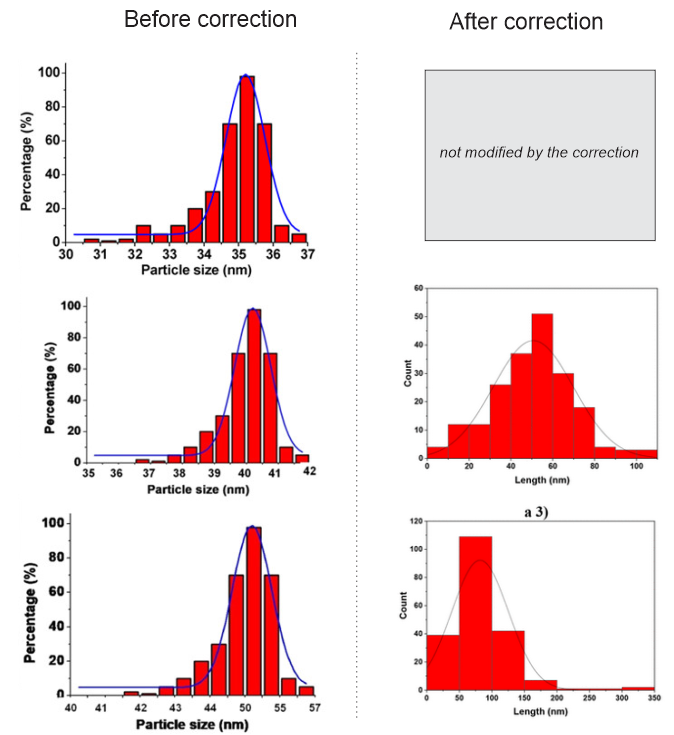
Here yet another, corrected already in February 2021:
Célia Arib , Jolanda Spadavecchia, Marc Lamy De La Chapelle Enzyme mediated synthesis of hybrid polyedric gold nanoparticles Scientific Reports (2022) doi: 10.1038/s41598-021-81751-1,
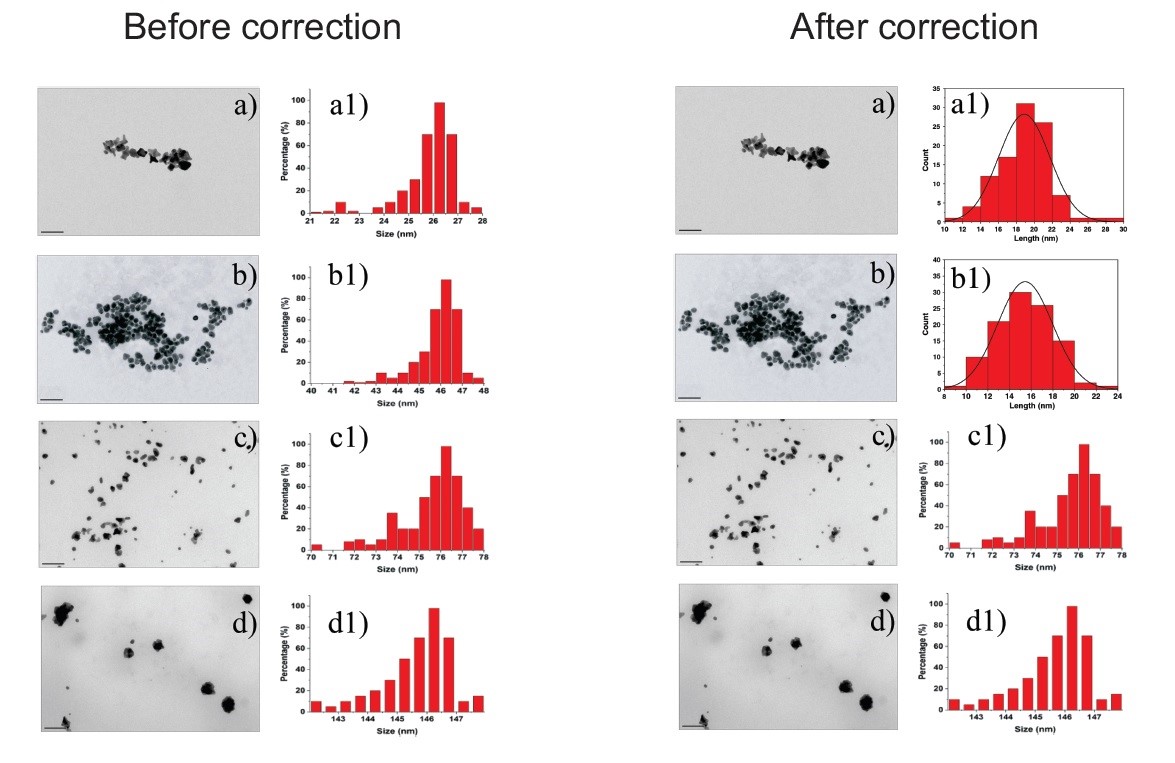
“In the panel a1, the initial histogram showed a narrow distribution with most particles between 25 and 27 nm. After correction, most particles are between 14 and 24 nm.
In the panel b1, the initial distribution was narrow with most particles between 45 and 47 nm. After correction, most particles are between 12 and 20 nm. Clearly the inital histogram was wrong since the particles are much smaller than the 50 nm scale bar.
Panels c1 and d1 have not been corrected, yet they are also wrong. The histograms indicate sizes of ~76 nm for c1 and ~146 nm for d1 when in both cases the corresponding electron microscopy images show particles smaller than the 50 nm scale bar.“
The Italian-born senior CNRS researcher Dr Spadavecchia replied on PubPeer in a measured, professional way befitting a French or Italian academic:
“Dear Administrator,
I will not answer to such anonymous comment, from someone who seems ignorant in nanomedicine, nanoscience and law. I will try to spam block the messages sent by your company to me
With my best regards“
Basically, an unhinged screech of a classic academic sociopath used to terrorize people but unused to being criticised. Befitting indeed. She posted same in another PubPeer thread, where a journal allowed Spadavecchia to correct a paper recycling data from a different experiment.
Spadavecchia was slightly more restrained in her replies to Le Monde:
“To defend herself, the researcher, who responded to Le Monde, recognizes errors, due to her disorganization, which made her confuse curves. She denies the intentionality of these faults and rejects the term fraud. This would also be the misuse of data processing software. Arrangements would have been made in her laboratory to correct these data management processes. The management of the CSPBAT, which did not wish to answer us, did not confirm it.”
She is not the only nutcase in her team:
Fatima Aouidat , Zakaria Halime , Rosalba Moretta , Ilaria Rea , Stefania Filosa , Stella Donato , Rosarita Tatè , Luca De Stefano, Raphaël Tripier , Jolanda Spadavecchia Design and Synthesis of Hybrid PEGylated Metal Monopicolinate Cyclam Ligands for Biomedical Applications ACS Omega (2019) doi: 10.1021/acsomega.8b03266
Actinopolyspora biskrensis: “Figure 4 appears to have two images which overlap.“
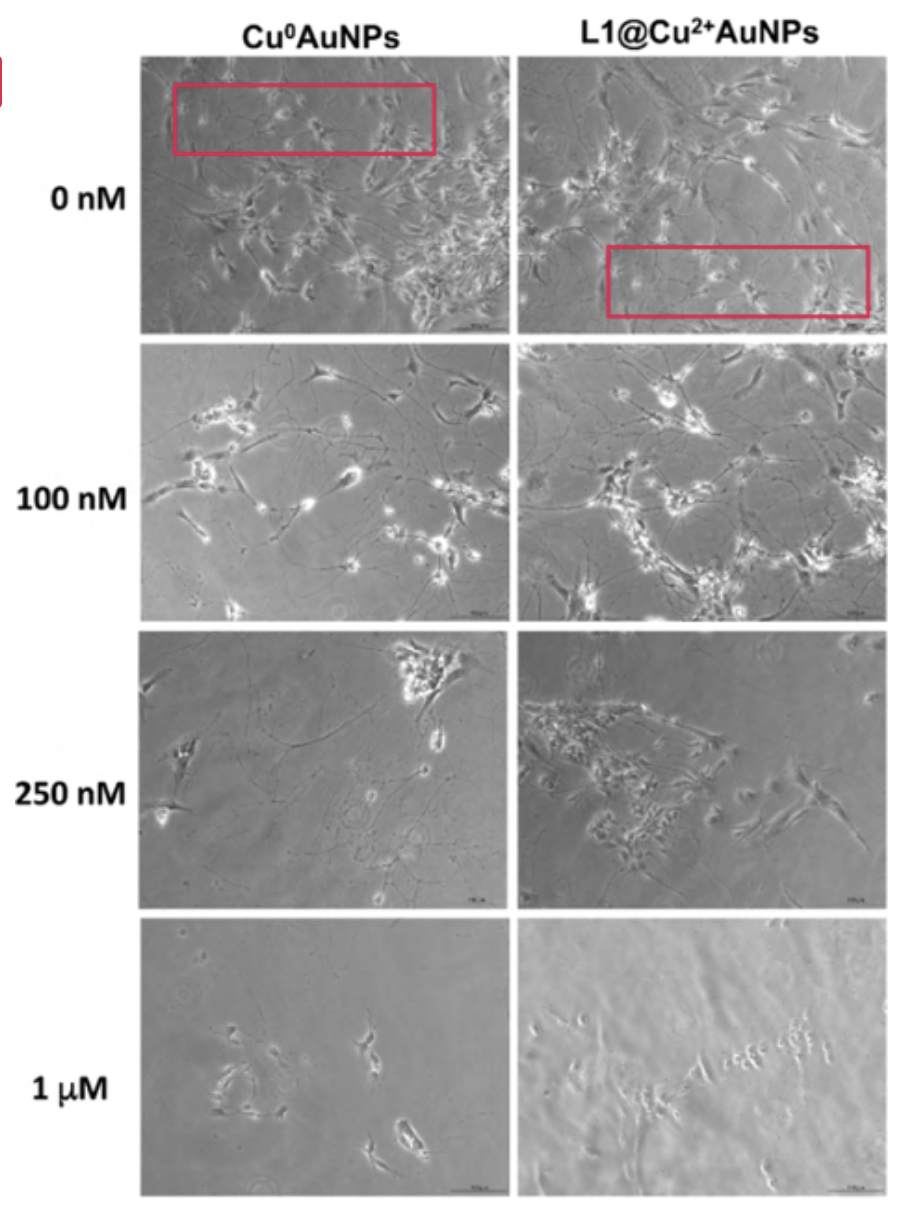
Cheshire received this reply from the co-author Luca De Stefano on PubPeer:
“Usually, I don’t reply to posts or emails from anonymous people or people hiding behind a nickname, especially when these concern observations that cast suspicion rather than create clarity, but in this case for the serenity of my co-authors and readers of the article in question, I will be happy to answer. A part of the two images seems to actually overlap, which means that they belong to two fields of view of the microscope of the same sample which is not by chance the control sample. In the experiment in question, the control sample serves to verify the healthy state of the cells, i.e. neurons from stem cells. Once this was verified, the cells were detached from the multiwell and separated in equal dilutions in different wells in triplicate and then inoculated with different nanocomplexes. Actually, the image of the control sample could have been the same because it represented the culture from which all the others were then taken to carry out the dose-response experiments. Having a single initial sample control is common when the biological material is not very available, very expensive or difficult to grow, as in the case considered. In any case, the use of those two figures does not affect in any sense the design of the experiment, nor the validity of the results obtained. Anyone interested in further clarification can write to the corresponding authors.“
None of that makes scientifically any sense, at all. Nobody runs experiments like this, not even the most stupid among research fraudsters. It is a trashy nonsense protocol which these data fudgers made up after having been caught. Anyone interested in further clarification can write to me, but there is already someone’s comment on PubPeer.
The editors of affected journals were contacted by the newspaper:
“The malaise is palpable among editors who have corrected articles. Contacted by Le Monde, they refer to the press services of the parent companies for answers: Springer Nature, Taylor & Francis or the American Chemical Society. Some claim to be unaware that the author requested these corrections following a scientific integrity investigation, or that some were related to reuses of the same figures in articles from other journals. […] Several papers flagged for errors, particularly in release curves, are still under review by editors.”
Do nanoparticles deliver? Merck’s Smart Flares and other controversies
Two somewhat controversial approaches to nanoparticle delivery: the striped nanoparticles by Francesco Stellacci, and the spherical nucleic acids by Chad Mirkin.
UCL trachea transplants: Videregen sets lawyers on Liverpool academics Murray and Levy
Videregen, the Liverpool-based company which bought the trachea regeneration patent from UCL, deployed lawyers against the academics Patricia Murray and Raphael Levy, precisely via their employer University of Liverpool. Main issue is the parliamentary submission by Levy and Murray, subject to absolute privilege. Yet Videregen also cites from the confidential notice of suspected research misconduct…
It turned out, the whistleblower was Raphael Levy, a “scientific terrorist” (my readers might recall his name):
“During this time, the atmosphere deteriorates at the CSPBAT. Some criticize the whistleblower for not having discussed his report with the responsible director before sending it to the referents, triggering open animosity against him, pushing the university to change his assignment. Some of his former colleagues even think he wants to settle scores. According to our information, this is one of the lines of defence followed by Jolanda Spadavecchia, who even speaks of harassment. What the latter “rejects entirely” and qualifies as “unfounded”: “Analyzing and reporting errors does not constitute harassment but, on the contrary, is part of the normal activity of the researcher. The university presidency did not respond to our requests for clarification on this situation.
Sign of this tension, in November, a new article by Jolanda Spadavecchia was corrected. It contained, at the very end, an unpublished and inappropriate statement: “We have a conflict of interest with Raphaël Lévy. At the request of the latter, this mention was withdrawn one month after its publication.”
I don’t know which academia is more fraudulent and more toxic, French or Italian. But Spadavecchia’s case combines both worlds.
Stanford meltdown
The affair around the President of Stanford University, Marc Tessier-Lavigne, exploded and is all over the national media. I wrote about it before, in fact the evidence is 7 years old, and everyone knew of it. But out of the blue, some days ago Stanford daily reported about the PubPeer evidence, and every other newspaper and TV followed suit. Now Stanford announced an investigation, which they have been refusing to initiate for 7 years.
Science misconduct
Scholarly publishing is broken, and no repair is possible. At least let’s point fingers at the elites and laugh. Can science trust Science?
On 2 December 2022, Stanford Daily brought a follow -up that even more papers were found to be problematic, thanks to PubPeer commenters (more on that in a moment). On 5 December 2022, Stanford Daily brought this scoop about the new Stanford investigation:
“Felix Baker, the only trustee who was appointed to the committee with a bioscience background, will no longer be a member of the committee. This comes after The Daily discovered that Baker’s investment firm, co-founded by him and his brother, maintains an $18 million stake in Denali Therapeutics, a biotechnology company co-founded by Tessier-Lavigne. Now serving on its board of directors and as a scientific advisor, Tessier-Lavigne maintains more than $50 million of stock in Denali.
On 6 December 2022, Stanford Daily informed:
“University President Marc Tessier-Lavigne addressed Stanford faculty about allegations of research misconduct in papers he co-authored just hours before the research journal Cell announced it would be reopening an investigation into one of the papers in question.
Tessier-Lavigne, whose research is under investigation by the Board of Trustees as well as three prominent research journals, wrote he regretted “the impact these events are having on the university.”
In his Monday email, Tessier-Lavigne distinguished between three papers — a 1999 Cell paper and two 2001 Science papers — on which he was the senior author and several other papers on which he was a co-author.
The statement, also released to the Tessier-Lavigne lab website, said that he is in communication with Science and Cell to “determine the appropriate next steps” about new concerns raised regarding the papers on which he is the lead author. Tessier-Lavigne added that, in the papers he co-authored, the “specific images that are being queried are from collaborators’ laboratories.”
However, Tessier-Lavigne wrote, “I want to be clear that I have never submitted a paper without firmly believing that the data were correct and accurately presented. I also want to be clear that I take responsibility for any concerns that arise with respect to any work with which I have been involved.””
If you ask me (please ask, nobody else does!), this is what happened. Marc Tessier-Lavigne (MTL) is a very, very powerful man in US academia, but so are many others. These men are not necessarily all friends and wish the best for each other. My suspicion is that due to whatever multi-million dollar money pie MTL and other alpha males couldn’t share peacefully, someone phoned the Stanford Daily journalists and said: Now you can write about him. Which the journalists, sitting on the suppressed information for 7 years, then finally did. Right now, many among the US academics must be at each others’ throats, divided into two camps, for and against MTL (i.e., those who owe him their careers, and those who seek revenge for whatever they think MTL took from them).
As on cue, MTL’s loyal collaborators are now solemnly declaring that it was all their fault and MTL is entirely innocent. Like here:
Viola Maier , Christine Jolicoeur , Helen Rayburn , Noriko Takegahara , Atsushi Kumanogoh , Hitoshi Kikutani , Marc Tessier-Lavigne, Wolfgang Wurst, Roland H. Friedel Semaphorin 4C and 4G are ligands of Plexin-B2 required in cerebellar development Molecular and Cellular Neuroscience (2011) doi: 10.1016/j.mcn.2010.11.005

The Mount Sinai professor Roland Friedel blamed his first author, announced a correction, and added:
“I want to clarify that besides myself and the first author, no other co-authors were involved in experiments and data collection for Fig. 6. The co-authors Dr. Joliceur, Dr. Rayburn, Dr. Takegahara, Dr. Kumanagoh, Dr. Kikutani, Dr. Tessier-Lavigne, and Dr. Wurst have generated mouse lines and provided scientific advice for the studies of the paper, but were not involved in any way in data collection and figure preparation for this manuscript.“
Tessier-Lavigne’s PubPeer record now stands at almost 20 papers. Of course there will be no retractions, but everyone involved will want a shower after approving corrections for all that fraud. MTL will probably soon resign and leave Stanford and maybe even USA completely. Back to Canada? Into retirement?
But it is not MTL alone who is the problem. Let’s talk about the general f***ed-up-ness of science.
Look at this new discovery by Elisabeth Bik (and do note the second author!):
Yuru Liu , Elke Stein , Timothy Oliver , Yong Li , William J Brunken , Manuel Koch , Marc Tessier-Lavigne, Brigid L.M Hogan Novel Role for Netrins in Regulating Epithelial Behavior during Lung Branching Morphogenesis Current Biology (2004) doi: 10.1016/j.cub.2004.05.020
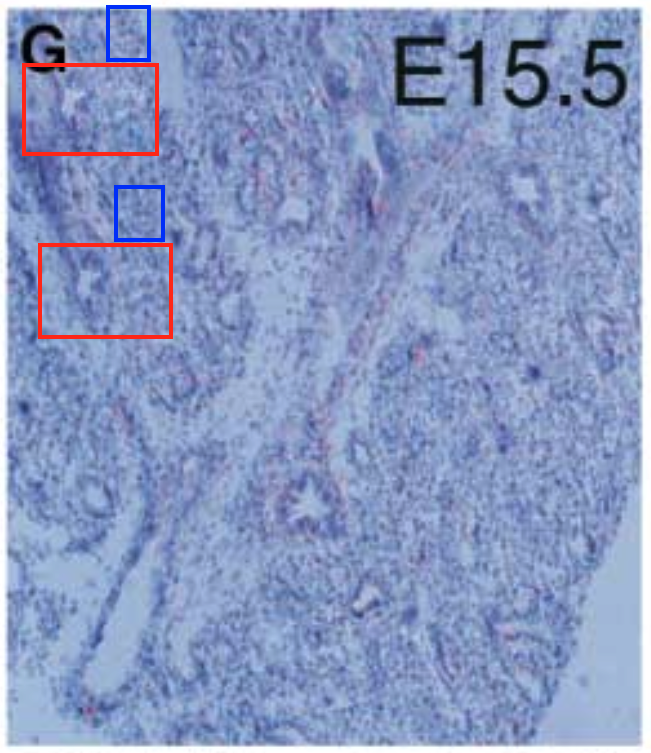

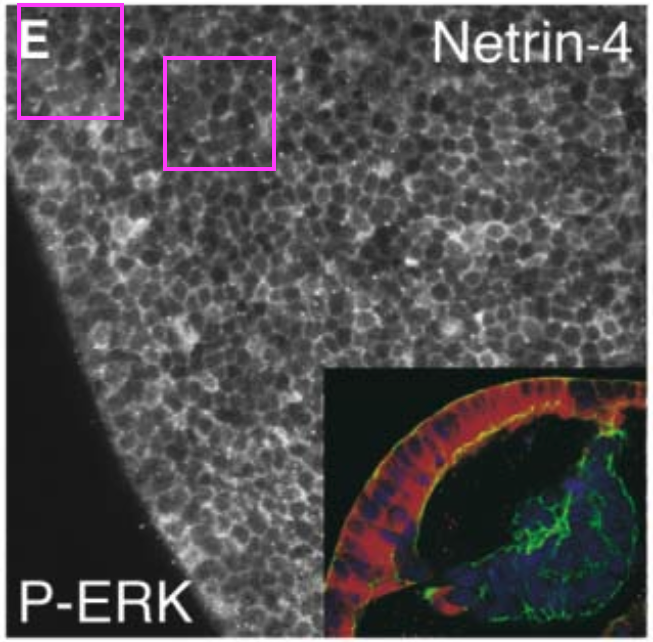

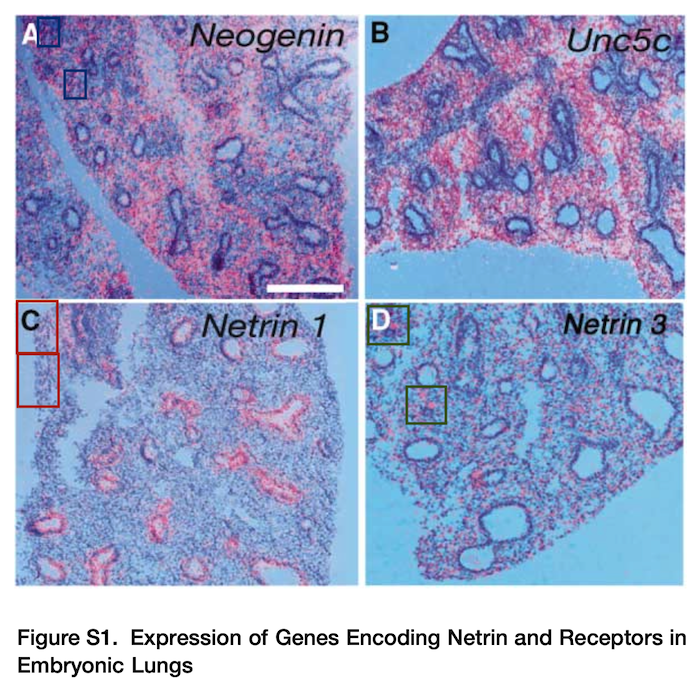
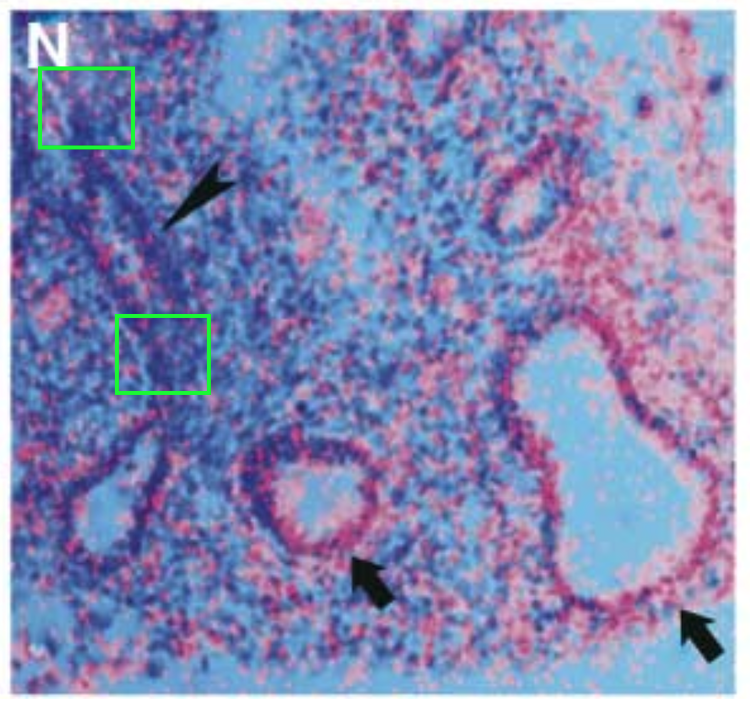


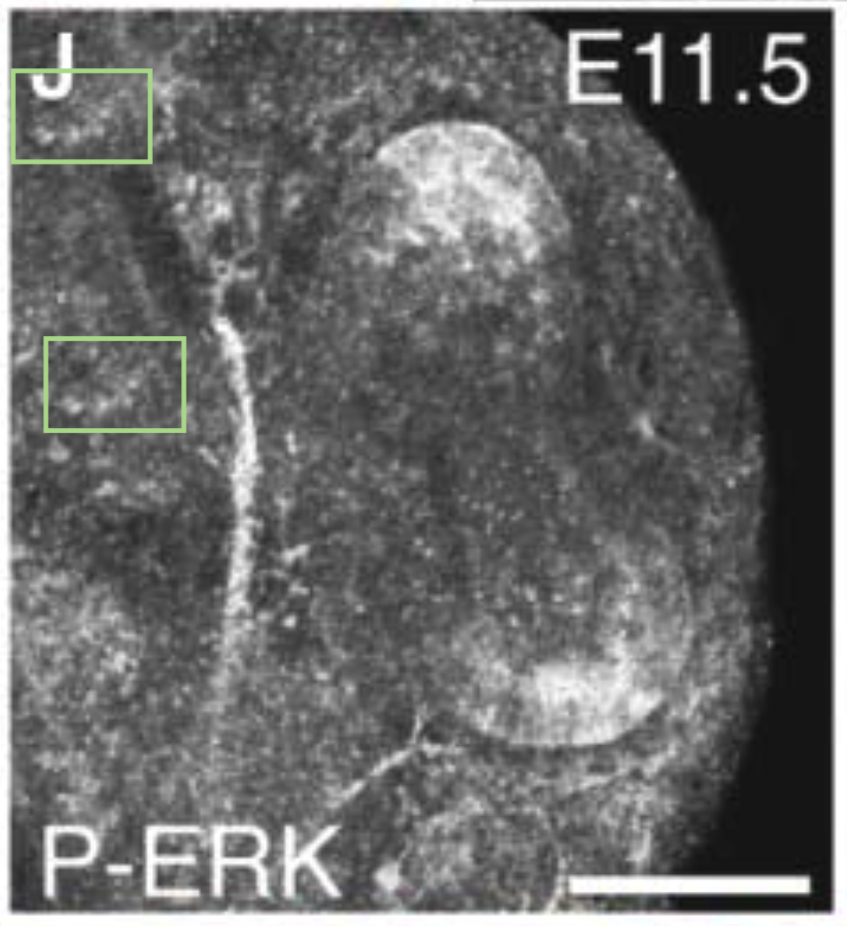
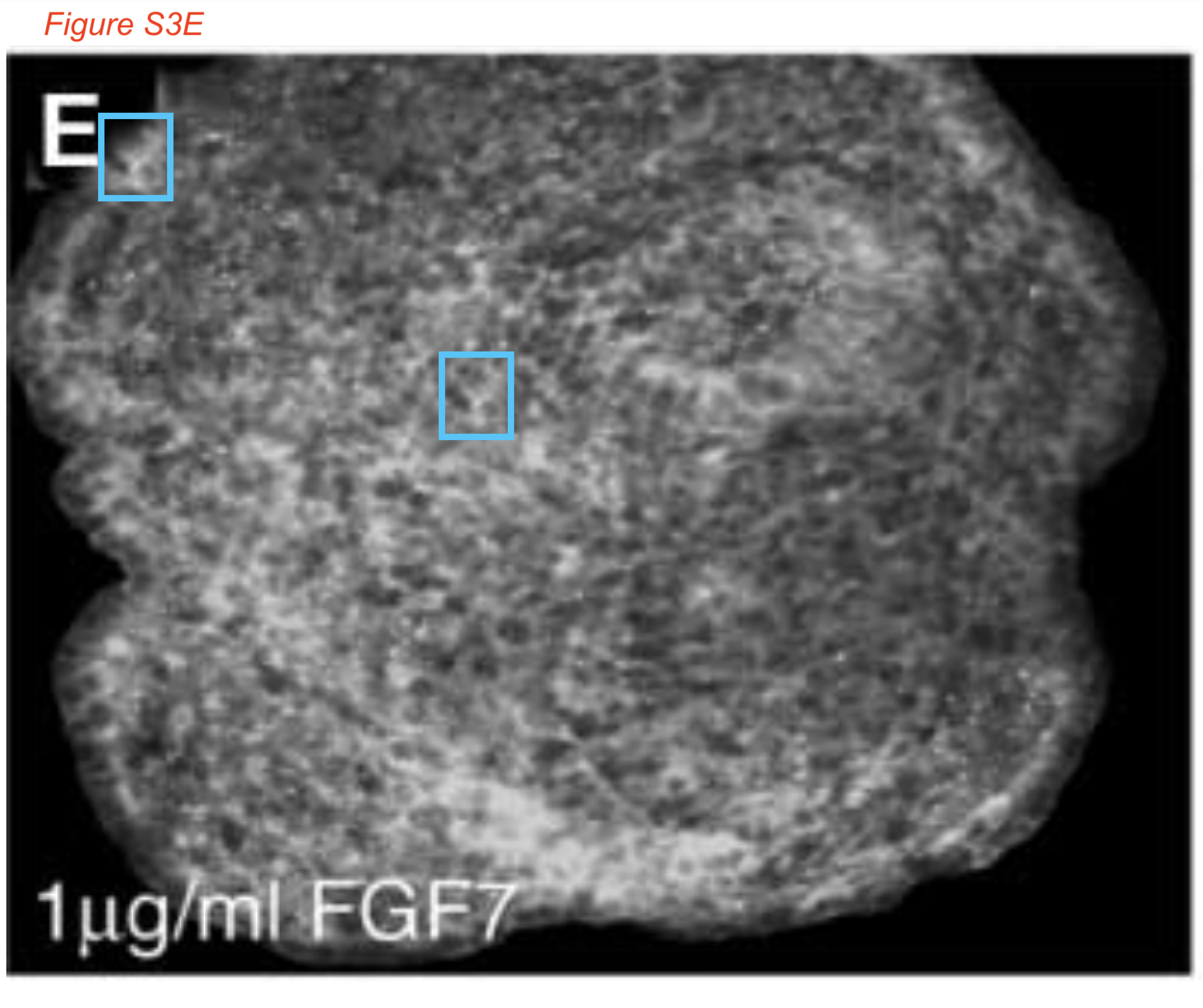
I can’t even fathom why MTL’s protege Elke Stein (or whoever faked all this), with MTL smiling on. Maybe the images are stolen from someone else’s published papers and original labels had to be erased. In any case, this is massive fraud.
Guess how the last author reacted?
Brigid Hogan, 79 year old retired professor at Duke University and Fellow of the Royal Society in UK, wrote this on PubPeer:
“I agree that the highlighted areas do appear to have some similarities. However, this must be by chance, reflecting in part the repetitive nature of the process of branching morphogenesis and the structure of the embryonic lung . For example, in panel M the areas are within a simple cuboidal epithelium and while the cell nuclei are in a similar configuration in relation to each other the staining of the apical surfaces is quite different. Likewise, in panel O the obligatory hexagonal packing of the cells gives a similar pattern of cell junctions but the staining of the cytoplasm is different. Importantly, there would have been no motivation whatsoever for us to deliberately duplicate the small regions highlighted since they do not affect the interpretation of the data.“
This denial of the obvious is just mind-boggling. Is Hogan suffering from old age dementia? Is she rather cunningly pulling our leg, and we don’t get her fine English humour? She is not replying to mine or anyone’s emails.
In any case, Hogan is covering up fraud. As MTL and his Stanford did and still do.
And as for why MTL was allowed to give his failed-scientist Stein a faculty job Stanford, despite her being a paranoid loony and despite everyone knowing of her data fudging skills, well, if you do insist on asking, I can only widely speculate here that maybe, just maybe Elke and MTL are, or used to be, really, really close friends. Friends with certain kind of benefits even?
We will know for sure if she follows him to where-ever MTL will bugger off soon.
The text above was corrected after I erroneously claimed MTL was French. He is a Canadian cheater of course, as Clare Francis pointed out.
Fish, dinosaurs and fraud
Science reports:
“In June 2021, paleontologist Melanie During submitted a manuscript to Nature that she suspected might create a minor scientific sensation. Based on the chemical isotope signatures and bone growth patterns found in fossilized fish collected at Tanis, a renowned fossil site in North Dakota, During had concluded the asteroid that ended the dinosaur era 65 million years ago struck Earth when it was spring in the Northern Hemisphere.
But During, a Ph.D. candidate at Uppsala University (UU), received a shock of her own in December 2021, while her paper was still under review. Her former collaborator Robert DePalma, whom she had listed as second author on the study, published a paper of his own in Scientific Reports reaching essentially the same conclusion, based on an entirely separate data set. During, whose paper was accepted by Nature shortly afterward and published in February, suspects that DePalma, eager to claim credit for the finding, wanted to scoop her—and made up the data to stake his claim.”
It was about this paper:
Robert A. DePalma , Anton A. Oleinik, Loren P. Gurche , David A. Burnham, Jeremy J. Klingler , Curtis J. McKinney , Frederick P. Cichocki , Peter L. Larson , Victoria M. Egerton , Roy A. Wogelius , Nicholas P. Edwards , Uwe Bergmann , Phillip L. Manning Seasonal calibration of the end-cretaceous Chicxulub impact event Scientific Reports (2021) doi: 10.1038/s41598-021-03232-9
During commented on PubPeer, also sharing the full text and figures of her Matters Arising manuscript:
“In December 2021 we asked the editors of Scientific Reports to conduct a proper investigation and request the raw data. They never got back to us with anything else than a promise that they would do so. This manuscript has been submitted to Scientific Reports Matters Arising on November 18, after which we were informed that Scientific Reports is in fact carrying out an investigation and they did receive raw data. This data and the reply by DePalma were shared with us this week by the authors, not in January when it was received by Scientific Reports, for reasons unknown to us. The data consisted of low-resolution photographs of wrinkled printouts with no time and date stamps and illegible numbers and graphs with no values on the axes. Very unexpected data for a modern mass spectrometer.”
Science also informs:
“DePalma, now a Ph.D. student at Manchester University, vehemently denies any wrongdoing. “We absolutely would not, and have not ever, fabricated data and/or samples to fit this or another team’s results,” he wrote in an email to Science. […] The raw data are missing, he says, because the scientist who ran the analyses [Curtis McKinney, according to Volkskrant, -LS] died years prior to the paper’s publication, and DePalma has been unable to recover them from his deceased collaborator’s laboratory.”
Blaming a dead co-author for destroying your raw data is of course a more advanced quality of lying than blaming a hungry dog or laptop thieves, but still.
Fossils research is all about controlling access. And DePalma literally had the key, as Science writes:
“During visited Tanis in 2017, when [During] was a master’s student at the Free University of Amsterdam. Her mentor there, paleontologist Jan Smit, introduced her to DePalma, at the time a graduate student at the University of Kansas, Lawrence. DePalma holds the lease to the Tanis site, which sits on private land, and controls access to it.”
Apparently, During and DePalma were supposed to work together, with the latter initially listed as second author on the former’s Nature paper. He instead wrote his own paper, with his Manchester PI Phillip Manning as last author.
Melanie A. D. During , Jan Smit , Dennis F. A. E. Voeten , Camille Berruyer , Paul Tafforeau , Sophie Sanchez , Koen H. W. Stein , Suzan J. A. Verdegaal-Warmerdam , Jeroen H. J. L. Van Der Lubbe The Mesozoic terminated in boreal spring Nature (2022) doi: 10.1038/s41586-022-04446-1
DePalma will soon learn that even his old New Yorker fame won’t protect him, after all – it’s just a measly expendable Sci Reps paper, his accusers published at Nature, and he is just a PhD student at the Silvia-Bulfone-Paus-University of Manchester. Now, if the fraud went the other way around, you would never read about it in Science or the newspapers.
Fiedler off the roof
A brief press release by the Association for Psychological Science (APS):
“APS Board of Directors Accepts Resignation of Perspectives on Psychological Science Editor-in-Chief
Today, December 6, 2022, at 9:35 a.m. ET (2:35 p.m. UTC), at the request of the APS Board of Directors, Klaus Fiedler, Editor-in-Chief of Perspectives on Psychological Science, submitted his resignation, which has been accepted.
APS’s commitment to scientific psychology and upholding the integrity of our journals remains steadfast.
The APS Board of Directors, committees, and staff are gathering information that will inform next steps for strengthening psychological science and our editorial processes, while combating biases and promoting a more equitable science.
APS Members and the psychological science community at large will play a crucial role in moving forward. “
Klaus Fielder is professor of psychology at the prestigious University of Heidelberg, Leibniz Prize laureate and member of the German Academy of Sciences, Leopoldina. What happened?
Well, here is a story by Washington Free Beacon from 6 December 2022:
“The editor in chief of one of the world’s most prestigious psychology journals, Perspectives on Psychological Science, resigned on Tuesday after the board of directors of the journal’s publisher demanded he step aside—or be fired—for soliciting academic criticism of a black psychologist.
The editor, the prominent German psychologist Klaus Fiedler, stirred up controversy by agreeing to publish trenchant critiques of a 2020 article by Steven Roberts, a black psychologist at Stanford University, who had argued, among other things, that “color-blind leadership” promotes “structural inequality.”
That led to a petition, published December 2 and signed by over 1,000 psychologists, that called for Fielder’s dismissal and, shortly thereafter, to an email from Robert Gropp, the executive director of the Association for Psychological Science (APS), which publishes the journal, arguing that Fiedler had violated the journal’s “diversity and inclusion policies,” according to an email obtained by the Washington Free Beacon. Gropp demanded that Fiedler resign or, he said, “the APS will move forward with terminating your editorship.””
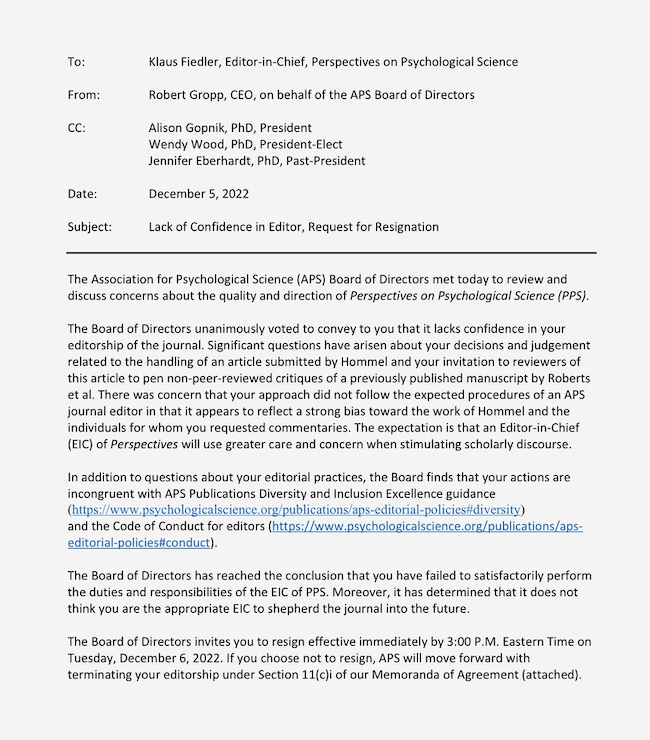
Free Beacon continues:
“Though Roberts, the Stanford psychologist, was invited to reply to the critiques, which are forthcoming with the journal, he pulled his paper after becoming convinced that the debate was “rigged” against him, he told the Chronicle of Higher Education. He then published the paper on a preprint service, PsyArXiv, on December 2, along with his email exchanges with Fiedler, which he claimed provided evidence of his unfair treatment—and, he implied, of Fiedler’s own racism.”
Among other things, Lee Jussim of Rudgers University was again being his usual racism-bating self, and Fiedler defended Jussim’s attacks. There were in total four critical letters published against Roberts, all authored by white men and therefore the only qualified experts on diversity.
Now, another editor of Perspectives on Psychological Science involved in cracking down on Roberts was a certain Bernhard Hommel. As Roberts wrote in his preprint:
“The initial critique of Roberts et al. (2020) that sparked the debate on diversity was entitled, “Dealing with diversity in psychology: science or ideology?”, with Bernard Hommel as contact author and Editor Fiedler as editor. The central premise of the critique was that Roberts et al. (2020) “showed worrying signs of ideological thinking and activism that has made its way into science” and that “uncritically accepting and introducing political activist arguments into science is likely to damage scientific freedom and independence” (Hommel, forthcoming).”
At that time Hommel, institute director at Leiden University in the Netherlands, already followed his wife Lorenza Colzato to TU Dresden in Germany after she was found guilty of research fraud in their joint papers.
Bad Choices in Dresden III
Lorenza Colzato was a rising star of psychology and a role model for Women in STEM. All Dutch media and even some local German newspapers talk about her now. But I want to talk about her husband Bernhard Hommel instead.
The Toronto-based psychology professor Uli Schimmack wrote on Facebook:
“Context: BerhnardHommel – best know for being an anti-anti-racism activist – is also known as husband of superstar fraudster (https://retractionwatch.com/…/university-recommends…/) #LorenzaColzato. . They both got jobs in Dresden (Germany). No wonder he doesn’t like social activism that wants to remove privileges that he enjoyed/enjoys.”
Hommel now an “anti-anti-racism activist”? Perfect for TU Dresden which defends him and his wife tooth and nail, since the city of Dresden and the surrounding state of Saxony already has a massive problem with racists and other anti-democratic tendencies.
Industry giants
Elon having fun
The beauty of being a billionaire is that you can perfectly legally torture and kill monkeys and not only you won’t get arrested, everyone will applaud you for saving the humanity. Just say you are into science, e.g., making brain implants. That’s why Elon Musk founded Neuralink, but it seemed he abused his employees also, so they are leaking things to authorities.
Reuters reports:
“Elon Musk’s Neuralink, a medical device company, is under federal investigation for potential animal-welfare violations amid internal staff complaints that its animal testing is being rushed, causing needless suffering and deaths, according to documents reviewed by Reuters and sources familiar with the investigation and company operations. […]
In all, the company has killed about 1,500 animals, including more than 280 sheep, pigs and monkeys, following experiments since 2018, according to records reviewed by Reuters and sources with direct knowledge of the company’s animal-testing operations. The sources characterized that figure as a rough estimate because the company does not keep precise records on the number of animals tested and killed. Neuralink has also conducted research using rats and mice.”
Musk bullies Neuralink employees for urgent results, the article gives the details. And:
“But current and former Neuralink employees say the number of animal deaths is higher than it needs to be for reasons related to Musk’s demands to speed research. […]
In some ways, Neuralink treats animals quite well compared to other research facilities, employees said in interviews, echoing public statements by Musk and other executives. […] In the company’s early years, Musk told employees he wanted the monkeys at his San Francisco Bay Area operation to live in a “monkey Taj Mahal,” said a former employee who heard the comment. Another former employee recalled Musk saying he disliked using animals for research but wanted to make sure they were “the happiest animals” while alive.
The animals have fared less well, however, when used in the company’s research, current and former employees say. […]
In February, an animal rights group, the Physicians Committee for Responsible Medicine, filed a complaint with the USDA accusing the Neuralink-UC Davis project of botching surgeries that killed monkeys and publicly released its findings. The group alleged that surgeons used the wrong surgical glue twice, which led to two monkeys suffering and ultimately dying, while other monkeys had different complications from the implants.”
Also many pigs were tortured for Neuralink’s “exploratory” research. All these experiments are legal, approved by US authorities, it is merely the aggressiveness with which they were done which brought Musk into trouble now.
Videregen’s new cash
The London university UCL and their trachea-transplanting partners, a failed Liverpudlian biotech fart-up Videregen got another wad of money from the British national funder UKRI. It is a message to all the scientists in the UK not to try anything honest or ethical because the money goes always towards the biggest crook, the more patients abused or even killed, the better.
New government cash for trachea transplanters Videregen
The trachea-transplanting company Videregen, based in Liverpool, got another £2 million grant from UK governmental agency Innovate UK, to advance their tracheal replacement technology.
UCL trachea transplants: Videregen sets lawyers on Liverpool academics Murray and Levy
Videregen, the Liverpool-based company which bought the trachea regeneration patent from UCL, deployed lawyers against the academics Patricia Murray and Raphael Levy, precisely via their employer University of Liverpool. Main issue is the parliamentary submission by Levy and Murray, subject to absolute privilege. Yet Videregen also cites from the confidential notice of suspected research misconduct…
The above articles are about Videgeren’s clinical trial with decellurised trachea patch seeded with bone marrow cells, for bronchopleural fistula. The trial’s start date has been moved by one year to October 2023, because it “is currently paused” as per official record, which also mentions:
“This is a novel therapy, there are no documented risks impacting subject safety. Possible related risks have been identified and documented in a non-clinical study conducted for the purpose of this clinical trial.”
That probably refers to all the dead patients subjected to trachea transplants using Videregen’s technology, also by UCL. Still, “no documented risks“.
The new grant is for £364k and will go from September 2022 till March 2024:
“This project will focus on the translation of world-leading UK research to deliver safety and efficacy data, to support development of a ground-breaking innovation that may transform organ transplantation by reducing/eliminating toxic immunosuppression, providing additional years of life, with reduced morbidities and cost.
The project uses ground-breaking technology to create a new thymus using biological tissue scaffolds and thymus cells. The bioengineered thymus has the potential to reprogramme the immune system such that recipients of organ transplants may recognise their new organ as “self” rather than reject it as “foreign”.”
I wrote about this before, when Videregen and UCL pocketed an earlier UKRI grant for thsi same crap:
After oesophagus, a thymus by trachea transplanters
Videregen and UCL are now making a thymus.
Of course there will be no lab-grown thymus at the end, at leats not a working one, just as it happened with the lab-grown trachea and lab-grown oesophagus, but there are fun plans to embezzle some money and to experiment on little kiddies though.
Scholarly Publishing
Not falsification
Journal of Cell Science issues an Expression of Concern for the Chilean neuroscientist Claudio Hetz, for paper from his PhD period.
The Claudio Hetz Blues
“…Dr. Hetz seems rather to regret that he did not have better tools for editing the figures, so that the undeclared interventions would have gone unnoticed.” – University of Chile investigative report.
Claudio A Hetz, Martin Hunn, Patricio Rojas, Vicente Torres, Lisette Leyton, Andrew F G Quest Caspase-dependent initiation of apoptosis and necrosis by the Fas receptor in lymphoid cells: onset of necrosis is associated with delayed ceramide increase Journal of Cell Science (2002) doi: 10.1242/jcs.00153
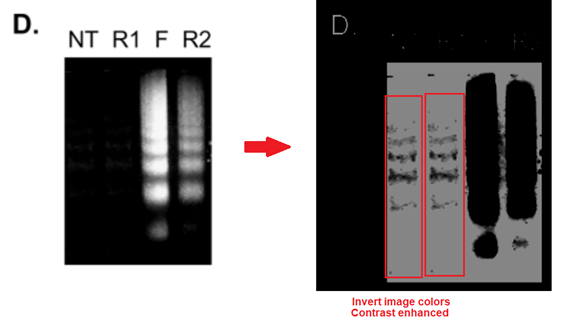
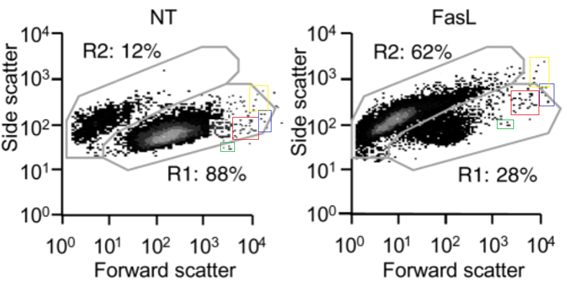
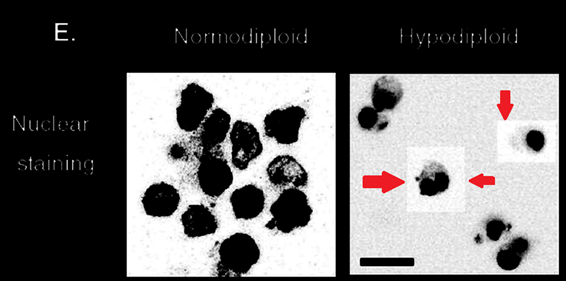
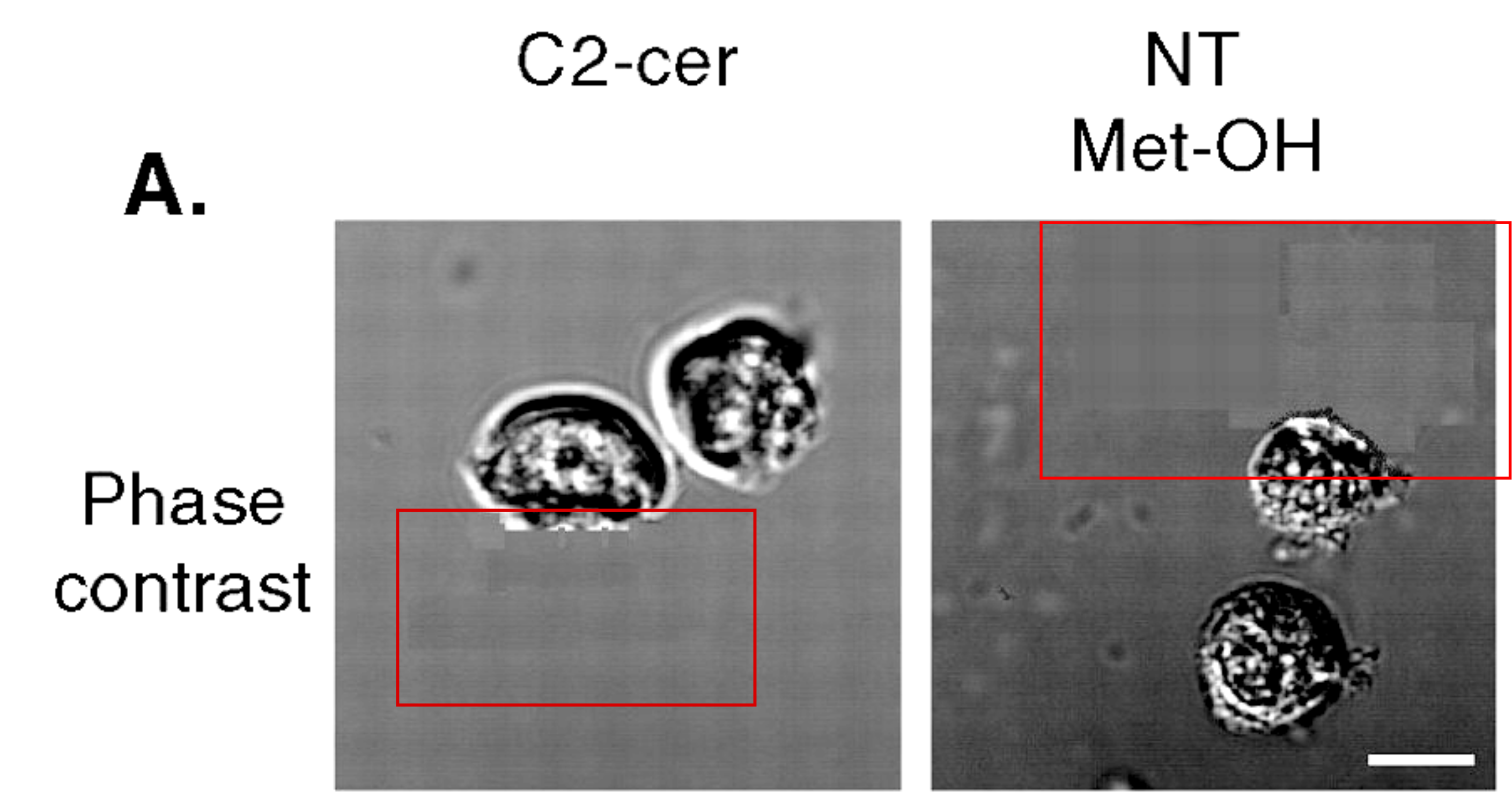
Hetz was investigated by his university based on my earlier reporting, the report did attest him research misconduct over a year ago.
On 6 December 2022, the journal issued this Expression of Concern:
“There are issues in J. Cell Sci. (2002) 115, 4671-4683 (doi:10.1242/jcs.00153).
There are irregularities with the background in Fig. 3E and Fig. 9A. Also, in Fig. 4, several data points are unexpectedly similar between the two FACS plots in panel A, and the first two lanes of the blot in panel D are duplicated. The authors no longer have the original data, but state that the conclusions of the paper are not affected.
A report by Instituto de Ciencias Biomédicas, Universidad de Chile, decided that there had been ‘to some extent data manipulation but not falsification’ of this and other papers authored by Claudio Hetz and concluded that the key findings of this paper are unaffected.
Without the original data, it is difficult to determine how these issues arose, so the journal is publishing this note to alert readers to our concerns.”
It’s ridiculous. The paper should have been retracted. But the academic non-profit publisher, Company of Biologists, is known to be run by chickens.
Catherine Jessus case: journals hide behind Sorbonne & COPE to avoid retractions
Jaw-dropping corrections issued for the French martyr saint of research integrity, Catherine Jessus, head of biology branch at the French CNRS. All these works of science contained such appalling Photoshop manipulations that the academic publisher had to bend over backwards and hide behind COPE guidelines to invent a reason against retractions.
Update: on 8 December 2022, the Chilean newspaper Interferencia reported (translated):
“in a communiqué coded for December 2022, this Faculty explained that: “the Faculty of Medicine of the University of Chile initiated an administrative investigation through Exempt Resolution No. 1213, of September 6, 2021, to clarify and establish eventual administrative responsibilities for alleged anomalies in scientific publications authored by tenured professor Mr. Claudio Hetz Flores. This investigation is finished, with the due control of legality”.
In this regard, it was held that “as a result of this process, Dr. Claudio Hetz has been definitively sanctioned, with the suspension of the position for a period of 2 months with enjoyment of 70% of the monthly remuneration, provided by the resolution Exempt 1087 of June 6, 2022 from the Faculty of Medicine. This suspension is valid from October 12 to December 11 of this year.”
A lesson learned
Scientific Reports learned from its past mistakes with papermill fraud.
Observe, published in June 2022:
Maryam Darvish , Navid Nasrabadi , Farnoush Fotovat , Setareh Khosravi , Mehrdad Khatami , Samira Jamali , Elnaz Mousavi , Siavash Iravani , Abbas Rahdar Biosynthesis of Zn-doped CuFeO nanoparticles and their cytotoxic activity Scientific Reports (2022) doi: 10.1038/s41598-022-13692-2

It was a classic fake Iranian papermill product, and a citation plantation:

More specifically, could the author explain how these two papers had “significant impact on life” ?
[65] Zhao, T.-H. et al. Quadratic transformation inequalities for Gaussian hypergeometric function. J. Inequal. Appl. 2018(1), 1–15 (2018).
[66] Zhao, T.-H., Yang, Z.-H. & Chu, Y.-M. Monotonicity properties of a function involving the psi function with applications. J. Inequal. Appl. 2015(1), 1–10 (2015).”
Alexander Magazinov noted:
“The citation statistics may be enlightening, demonstrating that this paper is a citation vehicle to the benefit of a certain YM Chu, and a certain C Li.“
The Highly Cited Researchers of Clarivate
“here is my advice to Clarivate: better get lost. ” – Alexander Magazinov
Electrochemical scam
Rule of the thumb goes is that one has to follow one research fraudster around to find many more.
So Alexander Magazinov followed Anthony PF Turner, the old crooked mentor and patron of the scamferencer Ashutosh Tiwari. Tony was found guilty of research misconduct and forced to retire by the Linköping University without emeritus status. He was also sacked as Editor-in-Chief of the Elsevier journal he founded, Biosensors & Bioelectronics. His and Tiwari’s fraudulent papers there were retracted.
Christmas messages from Professor Turner, his ex-protégé under investigation Tiwari, and Elsevier
My earlier article about the fake Linköping University professor Ashutosh Tiwari and his scam of predatory conferences and journals, made quite a splash. Swedish Linköping University (LiU) now opened an investigation into research misconduct and other “improprieties” of their past employee Tiwari. The investigation is likely to include his past patron, bioelectronics professor Anthony “Tony”…
Linköping investigation: Tiwari trips over Sharma’s fraud
The last act of the Ashutosh Tiwari travesty at Linköping University (LiU) in Sweden took place. Tiwari, the fake professor and master of predatory conferences, tripped only over his vanity of gift co-authorship on 3 papers by his Allahabad mate Prashant Sharma, a shameless nanotechnology data faker with presently 26 retractions.
But Turner is still pretending to be important, and his pre-Linköping employer, the Cranfield Universe in UK, allows him to call himself emeritus professor there. With that affiliation, Turner published a review paper. It appeared in April 2022 and already garnered 65 citations, so surely it must be very seminal, innovative, and all, right? Oh come on.
Anthony P. F. Turner Perspective—An Age of Sensors ECS Sensors Plus (2022) doi: 10.1149/2754-2726/ac5523
Of these 65, there are 31 citations in the Journal of The Electrochemical Society, 19 citations in the new Open Access journal ECS Sensors Plus (ESC standing for the Electrochemical Society) and 4 in ECS Journal of Solid State Science and Technology, all published by IOP Science.
This cannot be a coincidence. Obviously the Electrochemical Society is gaming its journal impact factors be extorting citations from authors. Magazinov noted:
“Well, the newly created ECS Sensors Plus (60-ish articles published so far) is actively gaining IF, the donors being other ECS journals, nothing to see here.“
ESC Sensors Plus is edited by an Ajit Khosla of Yamagata University, whose own April 2022 paper there, Chaudhary et al 2022, already has whooping 139 citations thanks to this interesting citation system by ESC journals. Magazinov found more scientifically rather worthless April 2022 reviews by other authors, which rapidly acquire citations to boost this journal’s impact factor: Stefan-van Staden 2022, Da Silva Santos et al 2022, Hyodo et al 2022 and Fan et al 2022.
Now thanks to the cheater Turner you met Khosla. Actually, it seems the entire Electrochemical Society are a bunch of metrics-rigging crooks who extort citations.
News in Tweets
- The world has forgot about the fake science of Angelo Vescovi, stem cell researcher at University of Milan Bicocca in Italy. But Elisabeth Bik did not: “According to this @RetractionWatch article from January 2016, the journal had started an investigation. Well, it has been almost 7 years“. Have a look at Binda et al Cancer Cell 2012, in December 2015 Vescovi commented on PubPeer: “we apologise for the mishap and, yes, the editor at cancer cell has been aware for a while of this issue, which was caused by mistaken classification and computer-assisted misassembling of the images scanned from the original plates.” Nothing at all happened since. And there is even more fake trash by Vescovi and his gang on PubPeer.
- Elisabeth Bik tweeted: “Ha! I just noticed that one of the “original images” in the seminal 2004 @JCellBiol paper by @mike_rossner and Kenneth Yamada about image manipulation …. is also photoshopped. Can you spot the image manipulation in the “Original Image”? Just to make clear, I love this paper, and I use it a lot in presentations. The images are meant to illustrate the temptation of digital alterations of photos, not to show actual data. Just wondering if this was an Easter Egg waiting to be found hahaha.” The paper was Rossner & Yamada 2004.
- A thread on papermill retractions at a Springer Nature journal: “”Autism, also known as autism, …” * “Autism can be alleviated by avoiding antiepileptic drugs during pregnancy [13]”, with while ref [13] is about the use of ceramics in dentistry.”
- Hindawi can’t restrain itself. Here is Yu & Zhao, Global Value Chain Governance of the Apparel Design Industry under the Background of Global Sustainable Economic Development Journal of Environmental and Public Health (2022) citing a paper on cancer and a paper on sewage.
- Speaking of papermills: Mark Griffiths, papermilling professor at Nuttingham Trash University in UK, published another trash paper (Salimi et al 2022) with fellow papermill customers from Iran. I can only speculate that these Iranians keep inviting Griffiths to join their papermilled manuscripts for free because he is WHITE and ENGLISH.
Nuttingham Trash University
“I will not by myself, or be instructing or encouraging any other person or howsoever othewise, publish or cause to be published words or otherwise howsoever make statements to others which wrongfully refer to Nottingham Trent University and/or their employees and for any person or any body associated with Nottingham Trent University”
- Speaking of Mark Griffiths, Elsevier’s Temporary Removal note on his paper Mamun & Griffiths 2020: “Frist and the foremost, the paper mentions the name of a person who committed suicide (in the third paragraph). Besides, there are comments in pubpeer doubts the scientific value and scientific rigor of the paper. The editor in chief and I are looking into this. In the meantime, in order to protect the person’s privacy, we ask you to help us take it down temporarily.“
- Gong & Liu 2022 used capital letters T instead of error bars, as Cheshire found out. “Advances in Materials Science and Engineering would like to express concern with the article titled “Monitoring of Sports Health Indicators Based on Wearable Nanobiosensors” [1]. Concerns have been raised regarding the underlying data and the error bars in Figure 9, as well as the methodology and the validity of the data availability statement. The publisher is investigating these concerns and will revisit this article with any necessary post-publication amendments.” Good luck investigating, dear Hindawi!
- Finally a Frontiers paper by Ashutosh Tiwari which befits both parties. Xie et al 2022 is about “swine manure slurry as liquid fertilizer“, an apt description for all involved.
The Indefatigable Ashutosh Tiwari
Four years after Ashutosh Tiwari’s scamferences and research fraud were exposed, his impressive-sounding yet fictional “International Association of Advanced Materials”, or IAAM, still opens doors, hearts and wallets.
- The Cassava fraudsters are now suing their critics for exposing the fake Alzheimer’s drug. It doesn’t matter the plaintiffs stand little chance in court: one can win simply when the accused runs out of money. Plus everyone else will be afraid to criticise Cassava, not wanting to get sued as well. Money is obviously not a problem for these crooks.
Cassava fraud and Alzheimer’s capitalism
“even Theranos didn’t submit fake data to FDA”
- In June 2022, the new member state candidate Ukraine fully joined EU’s Horizon Europe and Euratom Research and Training programmes. The first joint meeting took place on 18 November 2022: “Ukraine does not have to contribute financially for 2021 and 2022 and all the programmes’ applicants are encouraged to create opportunities for researchers and innovators from Ukraine.”
I thank all my donors for supporting my journalism. You can be one of them!
Make a one-time donation:
I thank all my donors for supporting my journalism. You can be one of them!
Make a monthly donation:
Choose an amount
Or enter a custom amount
Your contribution is appreciated.
Your contribution is appreciated.
DonateDonate monthly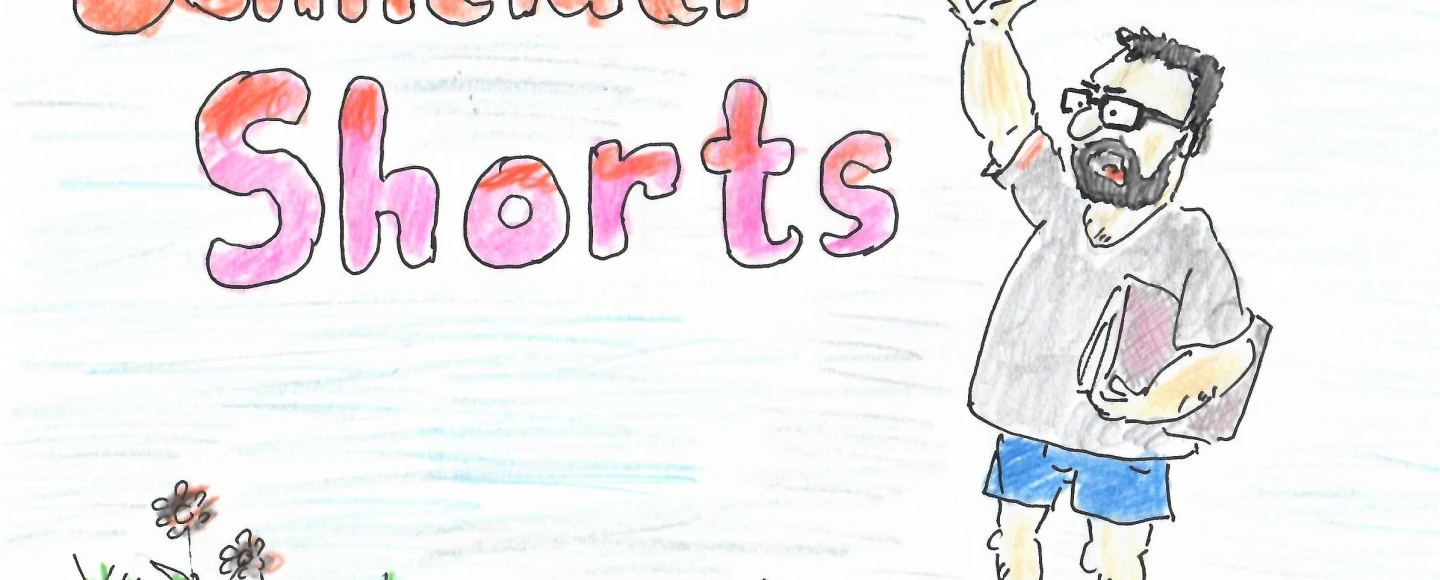


















You wrote that France will want Tessier-Lavigne back. I believe he is from the province of Ontario, Canada, not Quebec even.
LikeLike
You are right, my bad! Well, forgive me for associating impunity for research fraud with France 😉
LikeLike
Another prominent Stanford professor with a healthy Pubpeer record is Thomas Rando. https://pubpeer.com/search?q=Thomas+rando
He is now into the anti-lark, and doesn’t disclose conflicts of interest. Also, quite a bit of on the page western blot faking.
LikeLike
Good thing Rando published this fraud in Human Molecular Genetics (edited by Dame Kay Davies):
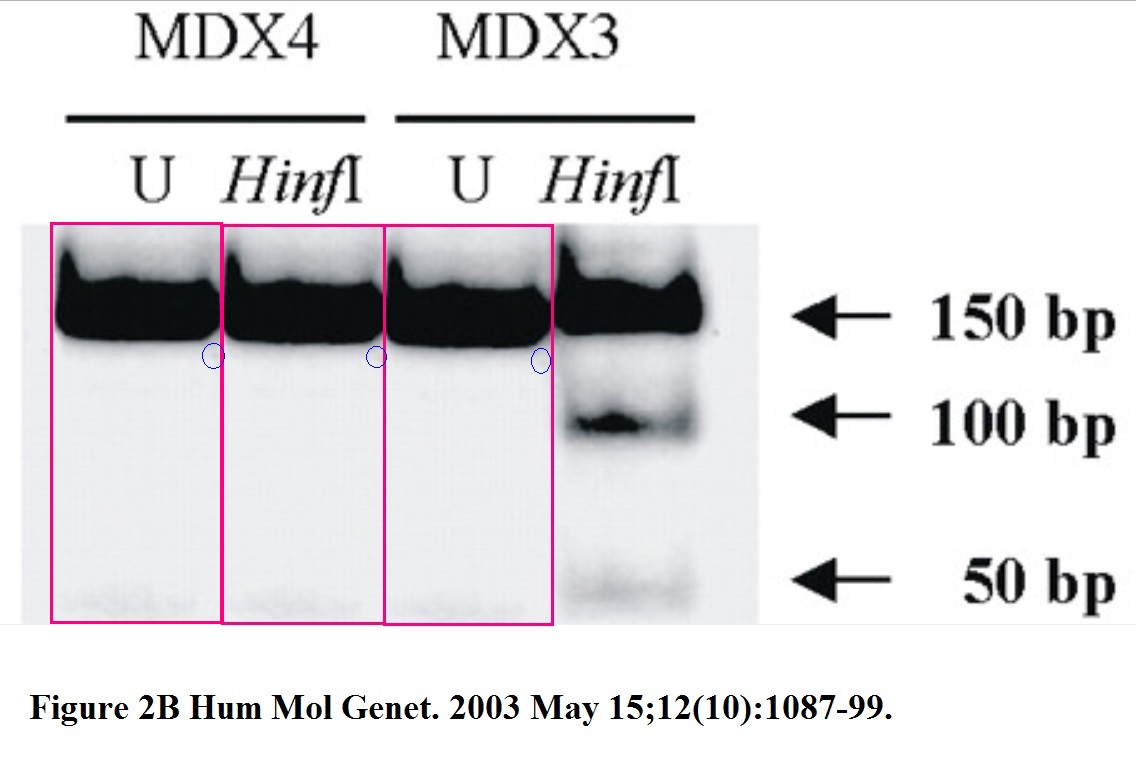
https://pubpeer.com/publications/67DC885563C5A31221C286B05D94E1
LikeLike
Yea, that’s right. Dame Kay Davies will grass on anybody who reports fake data to her journal.
LikeLike
We mustn’t forget that the jobbing physician, Amato Giaccia, was at Stanford for decades before his recent move to Oxford, England. England is very forgiving of data fraudsters giving Silvia Bulfone-Paus a professional position at the the University of Manchester after 13 retractions in Germany.
Back to Amato Giaccia and his committed at Stanford western fakery. https://pubpeer.com/search?q=Giaccia
LikeLike
Pingback: O’s digest biodiverso – ocasapiens
I’m sorry to comment with something unrelated, but maybe you guys can shed some light on this:
https://www.frontiersin.org/articles/10.3389/fnins.2022.1042865/full
Are they f-ing serious?
Authors credited:
Daniel Lee 1, …
1 Middleton High School, Middleton, WI, United States
LikeLike
Hahaha..Dr Lee and her school kid son found a cure for Alzheimer’s:
“This review aims to support the growing body of experimental and clinical data highlighting specific probiotic strains and particular dietary components in preventing Alzheimer’s disease via the gut–brain axis.”
LikeLike
Maybe he’s good with photoshop and excel?
LikeLiked by 1 person
Appearently, Jonathan Kipnis protected his postdoc mentee Kalil William Alves de Lima in an alleged sexual misconduct.
https://www.studlife.com/scene/2022/12/06/support-system-failures-cause-graduate-student-to-drop-her-wu-phd-degree/
He also tried to silent other PIs about this case on Twitter, last year
LikeLiked by 1 person